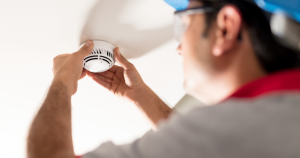Have you heard random beeps from your carbon monoxide device? Can you recall the last time you’ve had it checked?
Carbon monoxide (CO) poisoning is life-threatening. Neglecting the maintenance of your carbon monoxide devices can harm the people in your property!
According to the Center for Disease Control and Prevention (CDC), accidental CO poisoning has claimed the lives of 430 U.S. residents every year.
In addition, an estimated 50,000 U.S. residents are admitted to an emergency department because of carbon monoxide poisoning complications.
Carbon monoxide detectors must be installed to act as the first line of defense against the unseen threat of carbon monoxide to ensure the safety of your home and property.
Regularly maintaining CO detectors is an essential responsibility of a homeowner or a commercial building owner.
Read this article to learn more about how you can inspect your device and ensure it is not beyond its expiration date.
Types of Carbon Monoxide Detectors
CO detectors may be classified according to the mechanism of operation.
The three types are as follows:
- Biomimetic sensors work when high-concentrations of the gas block the laser inside before triggering the alarm,
- Metal Oxide Semiconductors (MOS) rely on the change of temperature between carbon monoxide gas interaction to a preheated semiconductor. The temperature change is proportional to the change of resistance, which triggers the alarm, and
- Electromechanical detectors operate when the interaction of air and carbon monoxide generates an electric current. When the current goes beyond the threshold, the alarm is set off.
As for the area of installation, there are also 3 classifications to choose from:
- A combination of a combustible gas/CO detector is usually used for areas that receive heating from natural gas space heaters.
- Digital display detectors are wall-mounted devices for household installation. They are installed within the eye-level because of the display.
- Non-digital wall-mounted detectors are installed 15 inches below the ceiling to detect carbon monoxide on high levels.
Do These Detectors Really Expire?
Just like any device ran with an electrical circuit, carbon monoxide detectors expire when the sensitivity of the sensor’s components dull because of its exposure to the gas for a long time.
The estimated time frame is usually five to seven years, but newly-manufactured models can reach up to 10 years.
Moreover, all detectors manufactured before 2013 should probably reach expiration by now.
If you’re a homeowner planning to install one, it would be easy to monitor its effectiveness by checking the expiry date behind.
But when renting a space with an existing device, you will not have any idea about it. It’s best to ask the establishment owner to avoid a potential safety hazard.
[Related: How to Install Smoke Alarms in your Home]
3 Ways To Check For An Expired Carbon Monoxide Detector

1. Check and take note of the expiration date
Over time, CO detectors expire because of high concentrations of carbon monoxide, which affects its sensitivity.
Your CO detector is expected to work for about 5 to 10 years.
To verify these, manufacturers put on expiration dates at the back of the device.
From 2009 to 2013, federal laws have been passed requiring state residents and commercial owners to install CO detectors.
Some of those devices should already be expired or nearing its expiry date this year, making inspection an urgent matter.
If you see that your device is nearing its expiration, schedule an appointment with a fire prevention specialist to replace your device with a new one.
2. Monitor the end-of-life signal for on both digital and analog alarms
Aside from the expiration date, manufacturers also integrated warning signals to notify owners of the device’s expiration.
For detectors with digital alarms, the screen will show an “ERR” or “END” message, which means the device is up for disposal.
You will also hear a “beeping” or “chirping” sound every 30 seconds, a signal that you should have it replaced.
Be mindful of the sound pattern when it rings. Most detectors signify when it detects high carbon monoxide concentrations through a different tone.
Intermittent beeping every 4 to 5 seconds alerts a carbon monoxide leak, which means you need to call the fire department.
On the other hand, carbon monoxide detectors that are non-digital exclusively flashes a red light with the beeping sound on a 30-second interval when the battery is drained.
The emitted signals should stop by replacing the batteries with new ones, and the device is ready to work again.
If the signals persist even after the battery replacement, your device has reached its end-of-life.
It is important to remember these indicators and immediately replace your carbon monoxide alarm to prevent CO poisoning.
3. Manually test your devices
It’s also good practice to manually test the functionality of your device.
Carbon monoxide (CO) detectors have an integrated “test” button on the back or front of the device.
Make sure to test monthly to evaluate the device’s performance and maintain its effectiveness.
To test your detector, follow these steps:
- Press the “test” button and wait for two beeps.
- If you don’t hear any sound or if the alarm is inaudible, replace the batteries.
- When the batteries are all new, but the sound is still non-existent, replace your detector.
For monitored detector installations, inform your provider beforehand to avoid triggering the emergency alarm.
It is also good practice to involve family members when testing the device. Assign them to certain places at home to check if the alarm is audible.
To ensure that the testing is professionally handled, hire a fire protection company to assess your device.
Check Your Carbon Monoxide Detectors Now!

It is your responsibility to protect your family members from the dangers of carbon monoxide poisoning by installing a detector and making sure it is fully functional.
Exposure to high concentrations of CO can lead to severe consequences.
If unsure as to what you should do, you can seek the help of professionals.
Assurance Electrical Services in Prescott, AZ’s, is your hometown electrician ready to cater to your electrical safety needs with integrity and accountability.
Do you have any questions regarding your carbon monoxide detector installation? Have you recently discovered that your device is expired?
Share your thoughts and leave a comment down below!
Jeff Brandlin is the founder of Assurance Electrical Services, LLC. He started in the electrical industry when he was 21 and had worked in several electrical firms before founding Assurance Electrical. Jeff is dedicated to providing the best quality service to his clients and always puts their needs first. Outside work, Jeff enjoys spending time with his wife and children.





